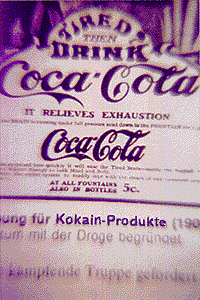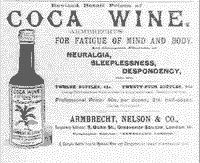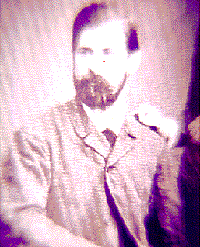

The
history of the extraction and study of cocaine
Cocaine
itself was first extracted and isolated from coca leaves in 1855 by Gaedecke
who called it Erythroxyline.
Whereas Dr. Albert Nieman extracted and
purified the compound naming it cocaine in 1862.
The total synthesis was confirmed by Wilstätter
et al. (1923). The full
stereochemistry of cocaine was determined one hundred years after its first
isolation by Hardegger and Ott (1955)1.
 |
Cocaine was widely distributed in elixirs (coca wine) and drinks like Coca-Cola. Indeed, Coca Cola contained small amounts of cocaine until 1904, which is how it obtained its name. Nowadays the pick-me-up in Coca-Cola comes from caffeine - a much safer alternative! |  |
 |
Cocaine was pioneered by the young Sigmund Freud, the neuropathologist, as a treatment for postnatal depression. Though these experiments were later discontinued due to the unwanted addictive side effects. He exalted the substance, which became widely used as a panacea (Cocaine Papers, Sigmund Freud, (ed. by R. Byck (1974))). His Interpretation of Dreams and the later development of psychoanalytic method may have been aided by cocaine. Aschenbrandt (1883) and Freud (1884) were the first to describe the effect of cocaine on the central nervous system (euphoria and a decrease in fatigue)6. |
Cocaine was
incorrectly used as a cure for morphine and alcohol habits.
Cocaine was discovered to be a local anesthetic by Koller
(1884) was the first effective treatment for nasal congestion associated with
seasonal allergies”. It has been reported that Queen Victoria and young house guest Winston Churchill took cocaine gum to relieve ailments whilst at Balmoral Castle. The
‘wonder’ drug was used by many of the great minds of the 19th
century, many of which became addicted. (John
Hopkins discovered nerve block anesthesia whilst becoming a cocaine addict.)
Cocaine is also of literary interest since Sherlock
Holmes supposedly took it, though it is alleged that Watson soon began to
disapprove7. It was banned in the UK in 1920 following reports of
'crazed soldiers' in the First World War also due to alarm about the addictive
potential of the drug and its ability to induce paranoia.